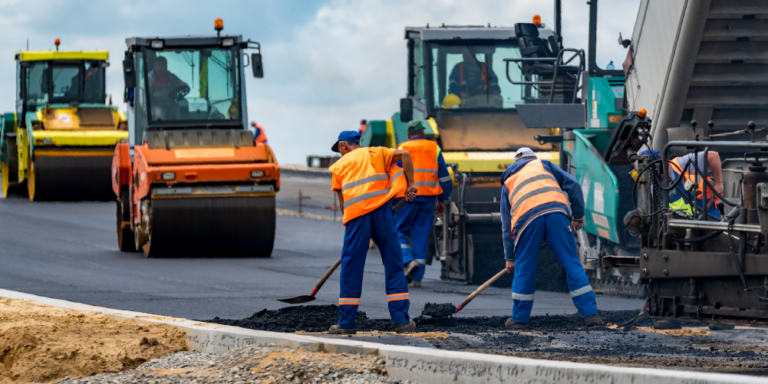— 10 min read
Building Pathways: What Sets Road Work Construction Apart


Last Updated Jun 19, 2024

Stephen Abadie
Infrastructure Team Lead
Stephen Abadie is an Infrastructure Team Leader at RNGD. Stephen joined RNGD in 2015 as the Infrastructure Division’s Assistant Project Manager. Now, as Team Leader, Stephen uses his 17+ years of professional expertise in major infrastructure and civil construction to lead a team of 85+ employees in talent development, lean project delivery, and execution of production systems, delivering quality products for RNGD's diverse client base.
In his day-to-day, he directs his team on safety, quality, and production for all current and future projects. He enjoys leading a diverse group of personalities that span generations, learning from those with decades of experience, and mentoring the next generation of construction talent. A native of New Orleans, Stephen graduated from Louisiana State University with a degree in Construction Management.
Both construction and building relationships are his true passions, but when he’s not in the office or on-site, Stephen’s with family or spending time outdoors hunting or golfing. When he finds the time, he indulges in a good book or article about world history.

James Hamilton
Writer & Producer
85 articles
James Hamilton is a writer based in Brooklyn, New York with experience in television, documentaries, journalism, comedy, and podcasts. His work has been featured on VICE TV and on The Moth. James was a writer and narrator for the show, VICE News Tonight, where he won an Emmy Award and was nominated for a Peabody Award.
Last Updated Jun 19, 2024

Road work construction is fundamental to modern society, linking people to essential services and livelihoods while posing safety risks and traffic challenges. Building roads is unlike almost any other construction type: It demands long-term strategic planning, cross-jurisdictional cooperation and a deep understanding of the environment, the economy, history and technology.
This article explores road construction, including how it happens, common challenges and what makes it different from vertical construction projects.
Table of contents
The Basics of Road Construction
Road construction generally refers to building new roads or reconstructing old ones. New construction can create connections between communities and economic centers, already existing roads and highways or it can quite literally pave the way for future economic development. Reconstruction projects can fix aged and potentially dangerous roads, improve drainage or increase a road’s capacity by widening it or updating its traffic engineering.
Road construction can be a deceptively complex process. Utilities like electricity, gas, water or internet often run alongside or underneath roads. Most projects require extensive coordination with utility companies, constant communication with utility users, and thorough referencing of public records to avoid damaging utilities.
Projects also require the engineering and construction of many different elements, such as:
- Pavement
- Lights
- Medians
- Painting
- Drainage
- Landscaping
- Traffic, including traffic lights and communication systems
- Pedestrian access
Roads and road construction involve a particularly high number of stakeholders. Most roads are commissioned and managed by a city or a county, while the federal government manages the interstate system. However, many roads move through numerous jurisdictions.
For example, Florida’s U.S. 90 is maintained by the Florida Department of Transportation, has concurrencies with many county roads throughout its length and connects to numerous federal interstates or interstate auxiliary roads. There are even more stakeholders when accounting for community groups and utility companies.
Throughout road construction, general contractors (GC) are constantly navigating the needs of these stakeholders, accounting for regulations that might differ between jurisdictions, and often submitting for payment from numerous sources.
The Phases of Road Construction
Constructing roads often takes many years because of how many stakeholders are involved, the intense regulations and the many variables that arise when building in linear miles as opposed to square feet. Each phase of the process has characteristics that set road building apart from other types of construction.
Planning
Most road construction is commissioned at the local level, often by a city or county that has identified the need for a new road, perhaps to further economic development or alleviate traffic on existing roads, or for reconstruction, perhaps because the existing road is in disrepair, dangerous, or unable to accommodate traffic. The municipality will often contract with an engineering firm that will serve as the designer of record and as the owner’s representative throughout the project.
Much of the planning process involves extensive consideration and analysis of the project’s potential impact on communities, the economy, and the environment. Some different types of analysis might include:
| Impact area | Analysis |
|---|---|
| Environmental | Assess how the road might impact areas it passes through, in regards to water, erosion, wildlife, and plantlife. Projects that receive federal funding, move through federal land, or are under the jurisdiction of a federal agency are usually required to submit an Environmental Impact Statement (EIS). |
| Geotechnical | Assess the soil and ground, specifically for materials, wetlands, rocks, clay or anything that might make the build difficult or pose a threat to the life of the road. This helps decide the building methods, equipment, and materials that will be used in each segment of the project. |
| Drainage | Assess the need for drainage, as well as the flow of water and likelihood of extreme weather events. |
| Economic and social | Municipalities often work to determine what a road will bring to the areas it runs along and connects, as well as what it might cost them. Economically, this might consider the development the road could help or hinder, and, socially, this might consider the groups that benefit from the road, the neighborhoods it might connect or divide, and the buildings or homes that would need to relocate for it to be built. |
| Traffic | Determine how many people will theoretically travel through an area and how the road might be used. This information can be used to justify the building of a road, as well as determine its size and materials. |
| Safety | Consider the potential dangers of a road, including topography, visibility, weather, and wildlife. This informs decisions about signage, guardrails, road size, and speed limits. |
| Utilities | Reference master plans and as-builts to locate all existing utilities, and coordinate with utility companies to determine how to work around or upgrade them. This might include moving or burying power lines, replacing water pipes, relocating gas lines from under the road to alongside it, or updating telecommunication systems. |
Engineers will use all this information to design the plans for the road. Many places have requirements for the format of road plans, such as in Louisiana, which standardizes them and makes them easier to read. Some municipalities will provide detailed lists on materials approved for the construction of roads, such as in New Jersey. The U.S. Department of Transportation (DOT) provides guidelines on how to select and test materials before using them.
Preconstruction
Roads are often public bid projects, meaning a government agency puts out a call to contractors for a specific project that has already been designed and approved. Contractors provide bids with their methods, timelines, and cost estimates.
Once awarded a project, GCs spend a lot of time working on the installation of the utilities along or underneath the road. Most states require GCs to submit an 811, which tells utility providers the route of a dig, what streets will be closed and when. In return, the utility providers give GCs information about utilities that are already in the area. GCs will also work to notify people who will be impacted by the project, which might include information about road closures or outages of electricity or water.
As with other construction projects, GCs often spend this time procuring materials. Many of the materials will have been chosen by designers during planning. Asphalt and concrete are the most commonly used materials for pavement. Each material has reasons it might be best for a project:
| Asphalt | Concrete |
|---|---|
| Quick: Asphalt can be used as soon as it’s dry, which usually happens quickly. When working with asphalt, road closures are usually shorter and it is easier to have partial road closures, where crews work on one lane and others stay open. | Longer life: Concrete is often resealed between 5-10 years and can last many decades, while asphalt might need to be resealed or replaced every few years. |
| Easy to repair: Asphalt allows isolated issues to be repaired without replacing whole chunks of a road. | Aesthetics: Concrete can be made in a variety of colors and textures. |
Construction
Roads are linear, so the construction phase often moves through dramatical varying conditions. In a place like Texas, it’s common for one mile of a project to require excavating dirt, the next to require pulling clay, and the one after that to require a bridge to get past a river. GCs regularly use geotechnical analysis and weather forecasts to differentiate their preparation and building methods for different segments within a project.
What goes into building a road depends on its size, the surrounding environment, and local regulations. Many of the construction processes, such as excavation, paving, and finishing, are repeated in regular increments, possibly every 100 feet. So while each area poses new challenges, it can be easy to anticipate the process of what needs to be completed in each section. The process of building a road usually includes the following:
- Earthwork and excavation
- Installing drainage
- Paving
- Signage and striping
- Lighting
- Traffic systems
- Landscaping
For as much work goes into planning, road construction is full of discovering things in the ground that were missed or unknown. This is true for new roads being built in places where no one has dug before or for old roads, where records of utilities might be out-of-date or incorrect. The contractor is responsible for addressing these problems, which might range from an underground boulder, a brittle sewage pipe, or a sunken gas line.
Post-construction
Road construction projects are often delivered in stages or phases, so parts of the road can be used while other are worked on. GCs will regularly update important documents, such as as-builts, to reflect any and all changes made throughout construction. Unlike commercial building construction where these documents might all be submitted during closeout, GCs need to make these documents accurate and available at all times for utility companies and municipalities, who need to know, at a moment’s notice, where old utilities were, where they are now, and how they are hooked up.
Until the project is done, the GC is usually responsible for all risk incurred on the road. If, for example, a guardrail is broken on a completed section of road while the GC is working on another, the GC is still responsible for fixing it. Following the final handover, the municipality or DOT will usually assume responsibility for maintenance of the road and any legal risk associated with it. In some cases, such as a toll road, a company might be charged with maintaining the road.
Common Roles and Responsibilities in Road Construction
Engineering Firm
A municipality or DOT will often contract an engineering firm to design the road and serve as their representative throughout the project. During planning, the firm works closely with the government agency to design a road that is practical, safe and will last for as long as possible. Firms also assist or lead much of the analysis to prepare for the build. Throughout construction, the firm is charged with ensuring the road is being built correctly and approving the work of the GC.
Engineering firms usually have team members with various specializations, including drainage engineering, structural engineering, traffic engineering and roadway engineering.
General Contractor
Because road construction is so regulated and specialized, many municipalities have strict requirements for a GC to be considered for a project. The U.S. DOT has a guide of how small businesses can meet their requirements and land federal projects. Other places require contractors to be prequalified before bidding, such as in Tennessee.
Owners
The “owner” in road construction is usually a government entity, often a city, a county, a state’s department of transportation, or the federal department of transportation. Oftentimes, roads will move across numerous jurisdictions and the GC will have to coordinate with many agencies.
Best Practices for Road Construction
There are a few things that usually make road construction a more efficient and effective process.
Self-perform and cross-train.
GCs that specialize in road construction often try to have the ability to self-perform most tasks within a job, as opposed to contracting them out. Some GCs cross-train their crew members, so they are able to work in numerous disciplines. This helps them remain nimble in the face of ever changing variables and to minimize the amount of logistics usually associated with coordinating a large number of subcontractors.
Use advanced modeling.
Many contractors used advanced modeling technology such as Trimble Business Center, to create 3D models of what a new or reconstructed road is going to look like. Models are often done in increments of about 50 feet to ensure the model accounts for the changing conditions along a road. Models help identify how to plan for the many variables involved with road construction, such as drainage, utilities, and geotech.
Invest in digital record-keeping.
While it hasn’t always been the case, many GCs and municipalities in road construction have adopted digital programs such as Procore for recording and storing important documentation, particularly master plans and as-builts. This helps to keep records up-to-date and makes them easier to share with all the necessary stakeholders.
Stay updated on what’s happening in construction.
Subscribe to Blueprint, Procore’s free construction newsletter, to get content from industry experts delivered straight to your inbox.

Road to the Future
In many ways, road construction has built much of modern society. However, road construction also changes with society. In recent years, many municipalities and GCs have worked to better understand and consider the impact of road construction on all communities and on the environment. Because of digital records and improving technology, road construction will continue to improve the ways we connect people, places and vital services.
Was this article helpful?
Thank you for your submission.
70%
30%
You voted that this article was . Was this a mistake? If so, change your vote
Scroll less, learn more about construction.
Subscribe to The Blueprint, Procore’s construction newsletter, to get content from industry experts delivered straight to your inbox.
By clicking this button, you agree to our Privacy Notice and Terms of Service.
Thank you!
You’re signed up to receive The Blueprint newsletter from Procore. You can unsubscribe at any time.
Categories:
Written by

Stephen Abadie
Infrastructure Team Lead
Stephen Abadie is an Infrastructure Team Leader at RNGD. Stephen joined RNGD in 2015 as the Infrastructure Division’s Assistant Project Manager. Now, as Team Leader, Stephen uses his 17+ years of professional expertise in major infrastructure and civil construction to lead a team of 85+ employees in talent development, lean project delivery, and execution of production systems, delivering quality products for RNGD's diverse client base.
In his day-to-day, he directs his team on safety, quality, and production for all current and future projects. He enjoys leading a diverse group of personalities that span generations, learning from those with decades of experience, and mentoring the next generation of construction talent. A native of New Orleans, Stephen graduated from Louisiana State University with a degree in Construction Management.
Both construction and building relationships are his true passions, but when he’s not in the office or on-site, Stephen’s with family or spending time outdoors hunting or golfing. When he finds the time, he indulges in a good book or article about world history.
View profile
James Hamilton
Writer & Producer
85 articles
James Hamilton is a writer based in Brooklyn, New York with experience in television, documentaries, journalism, comedy, and podcasts. His work has been featured on VICE TV and on The Moth. James was a writer and narrator for the show, VICE News Tonight, where he won an Emmy Award and was nominated for a Peabody Award.
View profileExplore more helpful resources

Why do most construction strategies fail (and how to fix them)?
In this episode of The Power of Construction, hosts Sasha Reed and Brett King sit down with Helen Gawor, a strategist and transformation expert who challenges construction’s approach to strategy....

How AI Is Creating Big Advantages for Specialty Contractors
Every minute that an MEP contractor takes to file an RFI, untangle a scheduling knot, or search for a forgotten document is a minute spent not building something. Enter artificial...

How GCs Can Minimize Waste With a Strong Inventory Management System
Construction is a very fluid and fast-paced industry. Any given jobsite might have thousands of moving pieces, plus new items showing up on the loading dock day after day. In...

Construction Business Intelligence: From Data to Decisions
Leaders in the construction industry can now access a vast array of construction data through sophisticated construction business intelligence tools. Within this data lie insights that support daily decision-making and...
Free Tools
Calculators
Use our calculators to estimate the cost of construction materials for your next project.
Templates
Find a template to help you with your construction project tasks.
Material Price Tracker
Get the latest U.S. retail prices and view historical trends for common building materials.
Glossary
Explore key terms and phrases used in the industry.
